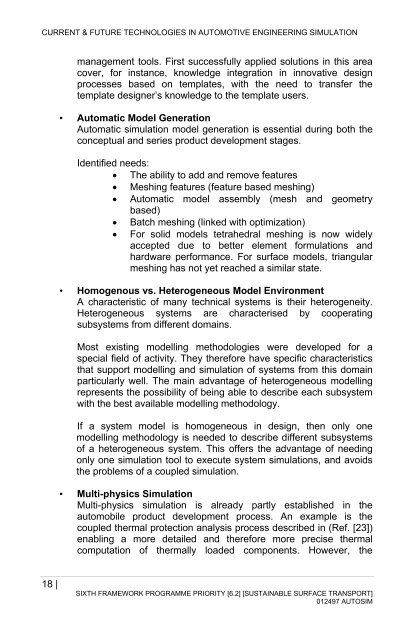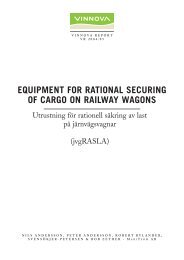Download - Autosim Autosim
Download - Autosim Autosim
Download - Autosim Autosim
You also want an ePaper? Increase the reach of your titles
YUMPU automatically turns print PDFs into web optimized ePapers that Google loves.
CURRENT & FUTURE TECHNOLOGIES IN AUTOMOTIVE ENGINEERING SIMULATION<br />
management tools. First successfully applied solutions in this area<br />
cover, for instance, knowledge integration in innovative design<br />
processes based on templates, with the need to transfer the<br />
template designer’s knowledge to the template users.<br />
• Automatic Model Generation<br />
Automatic simulation model generation is essential during both the<br />
conceptual and series product development stages.<br />
Identified needs:<br />
• The ability to add and remove features<br />
• Meshing features (feature based meshing)<br />
• Automatic model assembly (mesh and geometry<br />
based)<br />
• Batch meshing (linked with optimization)<br />
• For solid models tetrahedral meshing is now widely<br />
accepted due to better element formulations and<br />
hardware performance. For surface models, triangular<br />
meshing has not yet reached a similar state.<br />
• Homogenous vs. Heterogeneous Model Environment<br />
A characteristic of many technical systems is their heterogeneity.<br />
Heterogeneous systems are characterised by cooperating<br />
subsystems from different domains.<br />
Most existing modelling methodologies were developed for a<br />
special field of activity. They therefore have specific characteristics<br />
that support modelling and simulation of systems from this domain<br />
particularly well. The main advantage of heterogeneous modelling<br />
represents the possibility of being able to describe each subsystem<br />
with the best available modelling methodology.<br />
If a system model is homogeneous in design, then only one<br />
modelling methodology is needed to describe different subsystems<br />
of a heterogeneous system. This offers the advantage of needing<br />
only one simulation tool to execute system simulations, and avoids<br />
the problems of a coupled simulation.<br />
• Multi-physics Simulation<br />
Multi-physics simulation is already partly established in the<br />
automobile product development process. An example is the<br />
coupled thermal protection analysis process described in (Ref. [23])<br />
enabling a more detailed and therefore more precise thermal<br />
computation of thermally loaded components. However, the<br />
18 |<br />
SIXTH FRAMEWORK PROGRAMME PRIORITY [6.2] [SUSTAINABLE SURFACE TRANSPORT]<br />
012497 AUTOSIM
















